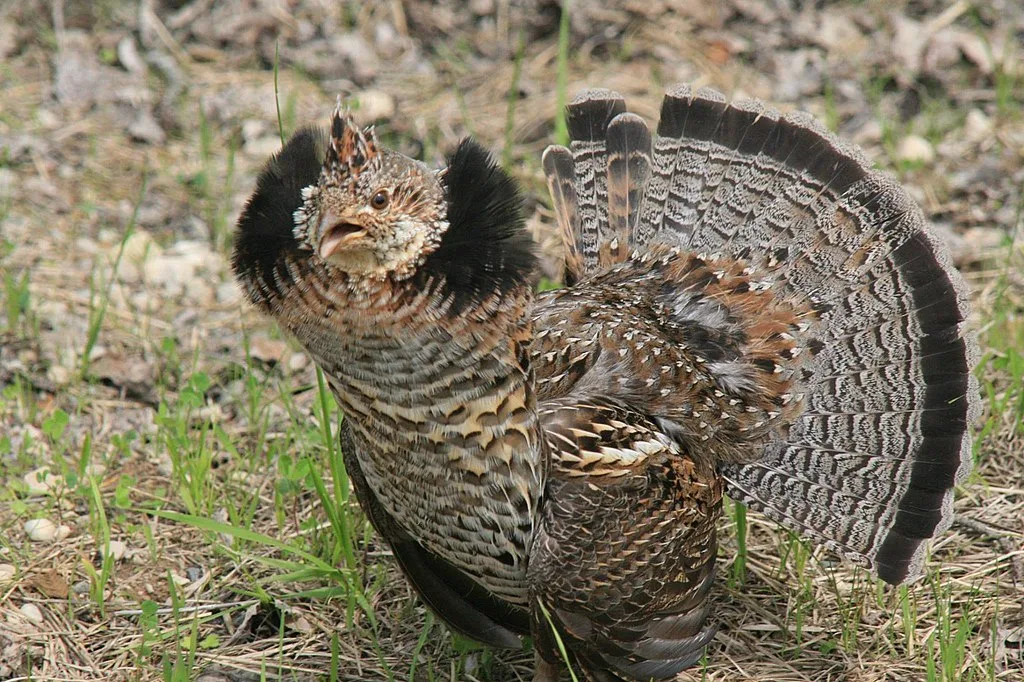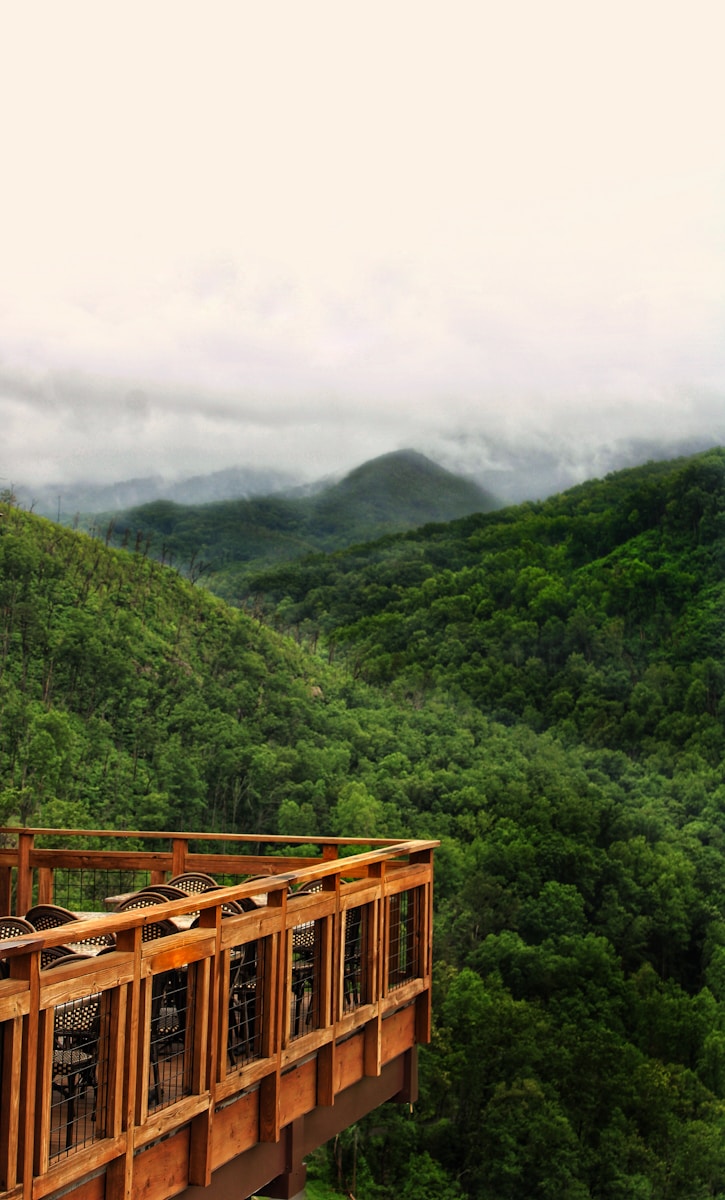Howdy folks! Grinning Gary here from Gatlinburg, Tennessee, where the critters come in all shapes and sizes – even the feathery kind! You might be headin’ to the Smokies for some sightseein’, but have you ever considered seein’ a Ruffed Grouse in Great Smoky Mountains National Park?

These aren’t your average park pigeons, mind you. No sir, Ruffed Grouse are the ninjas of the woods. They blend right in with the leaves and can disappear faster than a greased-up watermelon rollin’ down a mountain! But fret not, I’ll share some tips on their habits and the best times to spot these fascinating birds – prime Ruffed Grouse spotting in Great Smoky Mountains National Park is within reach!
The Smoky Mountain Surprise
The Great Smoky Mountains National Park, with its lush forests and diverse ecosystem, provides the perfect habitat for a variety of wildlife, including the elusive Ruffed Grouse. While you might be plannin’ your trip to the Smokies with sights like Chimney Tops or Clingmans Dome in mind, keep your eyes peeled for these feathered residents – a Ruffed Grouse encounter in Great Smoky Mountains National Park can add a whole new element of surprise to your adventure!
Now, these Ruffed Grouse in Great Smoky Mountains National Park aren’t exactly showin’ off for tourists. They’re more likely to be found scurrying through the undergrowth or perched on a low-hanging branch, camouflaged against the leaves. But if you’re stayin’ anywhere in Gatlinburg, nestled right by the park’s borders, well, you just might get lucky and have a run-in with one of these feathered fellas!
Those Wily Grouse: Unveiling the Secrets of the Ruffed Grouse in Great Smoky Mountains National Park
As I mentioned before, Ruffed Grouse are masters of disguise. Their mottled brown feathers mimic the forest floor, making them incredibly difficult to spot. But there are a few things you can look out for to increase your chances of a Ruffed Grouse sighting in Great Smoky Mountains National Park:
- Habitat: Ruffed Grouse prefer deciduous forests with dense undergrowth, which provides them with plenty of food and hiding spots. The Great Smoky Mountains National Park, with its sprawling woodlands, is a prime spot to find these birds.
- Behavior: While they’re mostly ground-dwelling birds, Ruffed Grouse can fly short distances in a burst of wings. They’re known for their drumming displays, particularly in the spring. The males beat their wings rapidly against their bodies, creating a low drumming sound that can be heard from quite a distance. Listen for this drumming sound during your hikes – it might just lead you to a Ruffed Grouse in Great Smoky Mountains National Park!
- Timing is Everything: The best times to spot a Ruffed Grouse in Great Smoky Mountains National Park are early spring mornings and dusk hours. During these times, they’re more active, searching for food or staking out their territory.
Find These Great Gatlinburg Related Items
A Birder’s Paradise: Beyond the Ruffed Grouse in Great Smoky Mountains National Park
The Great Smoky Mountains National Park is a haven for birdwatchers of all skill levels. While the chance to see a Ruffed Grouse is certainly a highlight, the park’s diverse habitat attracts a wide variety of other feathered friends. Here are a few other birds you might encounter on your Smoky Mountain adventure:
- Colorful Warblers: The park boasts over 80 species of warblers, each with their own unique plumage and song. Look for the vibrant yellow American Redstart, the cheerful Black-throated Green Warbler, or the elusive Ovenbird.
- Majestic Hawks: Soar through the skies with the park’s many hawk species. Keep an eye out for the Broad-winged Hawk circling overhead, the Red-tailed Hawk perched on a high branch, or the Cooper’s Hawk weaving through the trees.
- Cheeky Hummingbirds: The tiny Ruby-throated Hummingbird is a common sight in the Smokies. Watch as they flit between flowers, sipping nectar with their long, slender bills.
The Call of the Wild: Planning Your Smoky Mountain Birding Adventure
Whether you’re a seasoned birder or simply curious about the park’s feathered residents, the Smokies offer an unforgettable experience. Here are some tips to plan your very own birding adventure in Great Smoky Mountains National Park:
- Do Your Research: Before you head out, familiarize yourself with the different bird species found in the park. There are many resources available online and at the park visitor centers, including bird checklists and field guides.
- Choose the Right Gear: A good pair of binoculars is essential for spotting birds in the distance. Consider bringing a
- Consider bringing a camera with a telephoto lens to capture close-up shots of the birds you see. A notebook and pen can also be helpful for jotting down notes on your sightings.
- Pick the Perfect Location: Different areas of the park offer diverse habitats that attract different bird species. For Ruffed Grouse sightings, focus on areas with dense undergrowth and deciduous trees. Some particularly promising areas include:
- Middle Prong Trail: This moderate 5.5-mile loop trail in the Tremont area offers a good chance of spotting Ruffed Grouse in its rich deciduous forest. Keep an ear out for the drumming sounds during spring mornings.
- Alum Cave Trail: This moderate 4.4-mile out-and-back trail near Townsend is another good option. The lower section with its dense undergrowth provides potential Ruffed Grouse habitat.
- Rich Mountain Loop: This challenging 8.4-mile loop trail in the Cosby area is for experienced hikers. However, the rewards are plenty, with diverse birdlife and secluded areas where you might encounter Ruffed Grouse.
- Be Patient and Observant: Birding is all about patience and observation. Move slowly and quietly, listening for bird calls and keeping an eye out for movement in the trees and bushes.
- Embrace the Unexpected: The beauty of birding in Great Smoky Mountains National Park is the possibility of spotting something unexpected. You might come across a rare migrant or stumble upon a bird you’ve never seen before. Keep an open mind and enjoy the surprise!
Beyond the Checklist: Responsible Birding in the Smokies
While you’re out there enjoying the thrill of spotting a Ruffed Grouse or any other bird in Great Smoky Mountains National Park, remember to be a responsible birder. Here are some key points to keep in mind:
- Minimize Disruption: Birds are wild creatures and easily spooked. Avoid loud noises and sudden movements. Stay on designated trails and avoid going off-road to minimize your impact on their habitat.
- Leave No Trace: Respect the park and leave no trace of your visit. Pack out all your trash and avoid leaving any food scraps behind that could attract predators.
- Use Ethical Birdwatching Techniques: Avoid using playback recordings to attract birds, as this can disrupt their natural behavior. Always put the well-being of the birds first.
- Support Conservation Efforts: Consider getting involved in bird conservation efforts in the Smokies. There are many organizations dedicated to protecting bird habitats and populations, such as the Ruffed Grouse Society and the Tennessee Wildlife Resources Agency.
- By following these tips, you can ensure that your birding adventure in Great Smoky Mountains National Park is enjoyable for both you and the park’s incredible feathered residents.
Capturing the Perfect Shot: Ruffed Grouse Photography Tips
The chance encounter with a Ruffed Grouse in Great Smoky Mountains National Park is a sight to behold, but capturing that perfect photo can be a challenge. These birds are masters of camouflage and tend to flush out of sight quickly. Here are some tips to increase your chances of getting a stunning photo of a Ruffed Grouse:
- Be Prepared: Anticipate potential Ruffed Grouse sightings by focusing on areas with suitable habitat during early mornings or dusk. Have your camera with a telephoto lens ready and set to burst mode to capture multiple shots quickly.
- Focus on Lighting: Good lighting is essential for bird photography. Aim for soft, natural light during early mornings or evenings when the harsh midday sun can create unwanted shadows and glares.
- Camouflage Yourself: Wear camouflage clothing to blend into the environment and avoid spooking the bird. Maintain a safe distance and use a blind if possible for better concealment.
- Be Patient and Persistent: Ruffed Grouse encounters are often fleeting. Be patient, stay observant, and keep your camera ready. The more time you spend in their habitat, the higher your chances of capturing that perfect shot.
A Cultural Connection: The Ruffed Grouse and the Cherokee
The Ruffed Grouse has held a significant place in the culture of the Cherokee people who have inhabited the Great Smoky Mountains region for centuries. These birds were seen as a vital part of the ecosystem and played a role in Cherokee mythology and folklore.
- Food Source: The Ruffed Grouse was a hunted bird for the Cherokee, providing a source of food and feathers. Hunting practices were conducted with respect and followed sustainable traditions.
- Symbolism: In Cherokee mythology, the Ruffed Grouse was associated with the underworld and the spirits of the forest. Their drumming sounds were believed to carry messages from the spirit world.
By learning about the cultural significance of the Ruffed Grouse, we gain a deeper appreciation for nature and being aware of the damage to nature.
Stewards of the Land: The Cherokee understood the importance of maintaining a balanced ecosystem. Their hunting practices reflected this respect, ensuring the Ruffed Grouse population remained healthy. This traditional knowledge serves as a valuable reminder for modern visitors to be responsible stewards of the park’s wildlife.
The Enduring Allure of the Smokies
So, come on down to the Smokies! Grab your binoculars, lace up your hiking boots, and get ready to explore the park’s rich biodiversity. With a little planning and some patience, you might just have a chance to see a magnificent Ruffed Grouse in Great Smoky Mountains National Park. And even if you don’t, the stunning scenery, the crisp mountain air, and the symphony of birdsong will surely make your trip unforgettable.
The Smokies offer an adventure unlike any other. Whether you’re a seasoned birder or simply a nature enthusiast, the park has something for everyone. So come experience the thrill of the hunt for a Ruffed Grouse, learn about the cultural significance of these fascinating birds, and become a responsible steward of this irreplaceable natural wonder. The Great Smoky Mountains National Park awaits!




















Leave a Reply